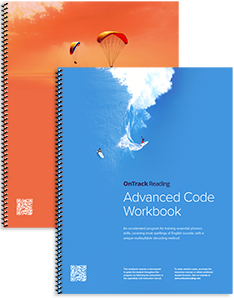For over a decade I used the OnTrack Reading Advanced Code Phonics Workbook with hundreds of clients in my private reading practice, ranging in age from seven to seventeen. Because a seven-year-old should be in the process of learning the advanced code, and because some teenagers don’t yet know the advanced code, this phonics workbook can be used for all ages once a child knows the basic code of one-to-one letter/sound relationships.
Typical Results
Here is what you should expect for results after eight to ten weeks of one-hour-per-school-day instruction provided you follow the instruction manual reasonably closely (though, of course, with kids there are no guarantees):
- Blending Skill should go to 100% on the blending test.
- Segmenting skill should go to 100% on the segmenting test.
- Auditory Processing Skill should go to 100% on the auditory processing test, provided you do the Oral Auditory Processing exercises described in the instructions if they are needed.
- Code Knowledge should go to 90% or above on the code knowledge test, and most of the overlap options should be known as well, provided you do all of the mappings, follow the instructions for numbering the overlaps as they are encountered, and teach the multisyllable decoding strategy in the workbook. The OnTrack Reading Multisyllable Method strongly reinforces the overlap options, that is, the various sounds a letter or digraph can represent.
- A guessing habit should be replaced by a decoding habit when your child encounters unfamiliar words.
- The habit of carelessly misreading common one-syllable words should be replaced by accurate reading of the actual words.
- Your child’s confidence when reading unfamiliar multisyllable words should increase significantly when using the strategy laid out in the workbook.
- You will realize that you are spending very little instructional time on worksheets, games, rules, etc., because your child quickly understands and begins to use the information being taught. I spent an average of only 18 to 20 hours with each young client in my reading practice to attain the results cited above, with a parent supervising worksheets for about the same amount of time at home.
That Cautionary Note, Again
However, and this is a very big “however,” if your child is fighting an undiagnosed vision problem, you will be putting the proverbial “cart before the horse” if you attempt to teach the advanced code phonics before seeing a developmental optometrist and addressing any serious vision issues that might be present. Yes, you can teach a vision-challenged child phonics, but it is much easier to do so when the child is willingly picking up books and practicing what has been taught. See Does Vision Therapy Work elsewhere on this site for more information.
Should you try the OnTrack Reading Phonics Program even if you suspect a vision problem but, for some reason, can’t go that route? Yes, it’s an effective phonics program, and you should see the gains indicated above, though they are likely to take longer to achieve if vision truly is an issue with your child. Regardless, the information in the workbook needs to be learned if a child is to become a skilled reader.





